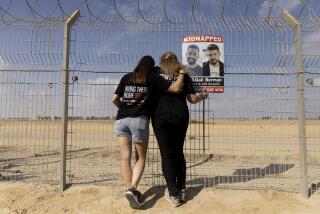Zionism Is in Eye of the Beholder
JERUSALEM — Ask Yisrael Harel what’s at stake in the removal of Jewish settlers from the Gaza Strip, and the answer won’t be measured in acres of land or number of homes. At risk, he says, is the very heart of Israel: the Zionist enterprise that brought Jews back to their homeland after centuries of exile.
“In the Israeli ethos, the Zionist ethos, settlements are of the essence. That’s why we came back,” said Harel, a newspaper columnist. Uprooting them, he said, would spell “the utmost negation of Zionism.”
Prime Minister Ariel Sharon is having none of that. “I am not prepared to listen to absurd claims that the disengagement from Gaza is the end of Zionism,” he countered in a recent speech, defending the government’s withdrawal plan. On the contrary, he said, pulling out from territory of “negligible” security importance is a “process that will strengthen Zionism.”
More than just tactical concerns, the decision to abandon Gaza has called into question long-held beliefs about the nature of this country and the meaning of Zionism, the founding ideology that led to Israel’s creation as a Jewish state on the land of the ancient Hebrew patriarchs.
Advocates and opponents of the Gaza withdrawal alike have been eager to cast themselves as the true upholders of Zionism. Will the pullout, as supporters insist, help guarantee the continued existence of the Jewish haven that the early Zionists envisaged? Or, as critics contend, will it undermine the restoration of what many Jews regard as their God-ordained ownership of biblical lands?
The impassioned debate has pitted Jew against Jew, synagogue against state, and notions of religious destiny against calculations of strategic survival. At root, the fight is in many ways an outcome of the ongoing clash between largely secular and more religious visions of this tiny nation, a struggle that has been brewing since Israel’s establishment in 1948.
“From the beginning, there was a kind of rivalry between these two codes,” said A.B. Yehoshua, an Israeli novelist. “Are we going toward the [secular] national interest, or are we the people of God that we have to fulfill a religious vocation?”
For many years, a relatively peaceable accommodation, and often some overlap, existed between the two camps, though the political leaders of the young state were primarily secular Jews. But the underlying divisions have widened since the 1967 Middle East War, a turning point in Israeli and Zionist history that has led to the agonized internal conflict over the planned Gaza withdrawal next month.
In the eyes of many here, the war was a miraculous, intoxicating triumph; for some, it seemed the fulfillment of prophecy. Surrounded by larger, hostile Arab neighbors, Israel managed to win the war in six days, capturing the Golan Heights, Sinai Peninsula, Gaza Strip, the West Bank and East Jerusalem.
“Even for secular Jews, the victory was almost religious,” recalled Aviezer Ravitsky, a professor at Hebrew University.
Overnight, the country found itself in control of a wide swath of territory that many here consider part of “Eretz Israel,” the “land of Israel,” a geography defined by the Bible.
Israelis swiftly began visiting previously inaccessible sacred Jewish sites, such as the Western Wall in Jerusalem and Joseph’s Tomb in the West Bank city of Nablus. And what had seemed fantasy -- reclaiming and resettling land perceived as a birthright -- suddenly became a practical possibility, backed by the tanks and guns of the Israeli army.
From the outset, many of the Jewish settlements were pioneered by so-called religious Zionists, who believed they were fulfilling God’s will by moving to the Palestinian-dominated West Bank and Gaza.
Governments on both the left and right backed the settlers, eager to expand Israel’s foothold and security in the Middle East. Many secular Jews were also supportive, among them the original Zionists, many of whom had little religious feeling -- some were even atheists -- yet saw the settlers as the new Israeli vanguard.
“Before ‘67, religious Zionism was a fringe,” said Tom Segev, an Israeli historian and journalist. But gradually, “many people came to believe that the occupation of the territories was the manifestation of true Zionist belief. And for many years, many Israelis shared that view.”
The move by religious Zionism toward the center of the political agenda coincided with the decline of its secular counterpart, whose vision of a socialist, democratic Jewish state had begun running into problems such as runaway inflation. As socialist ideology waned, religious ideology filled the gap.
“Let’s look at it as a car,” said Harel, the columnist, who is a religious nationalist. “The body was Zionism, but the engine was socialism. Once socialism disappeared, died out, they didn’t have an engine.... It’s true that the ’67 war gave us the fuel, but we detected [before that] that something was going wrong with Zionism and that we needed to take over.”
In Harel’s view, the secular Zionists -- the “old elites” -- have never forgiven religious nationalists for usurping the political spotlight and have pushed ahead with disengagement from Gaza as a way to get even.
“This is an opportunity to take a little bit of revenge,” he said.
Pullout supporters dismiss the accusation.
Segev, the historian, says he wants to rescue Zionism from what he describes as the monopoly and extremism of the religious right, to return to his idea of the Zionist basics: a pragmatic state with both a Jewish and democratic identity. If hanging on to Gaza and the West Bank, where Palestinians are the overwhelming majority, threatens that ideal, then they must be sacrificed.
“You can look at it one way, as the settlers and the right look at it, that this is a terrible blow for Zionism. But I say that it is very in accordance with the original Zionist dream, which is to have a democratic state with a clear Jewish majority, which we cannot have if we continue to occupy and oppress the Palestinians,” Segev said.
“The original Zionist movement ... was very pragmatic and knew when to make concessions. If you look at the original Zionist dream map, it really went from the Sinai to Damascus,” he said. “But the realization grew that you cannot populate all these territories.”
The costs of occupation, including the bloodshed of the Palestinian intifada the last five years, have fostered growing disenchantment with the settler movement and sharpened the need to pull out from strategically less important areas such as Gaza, Segev and others argue. So has the rising acceptance of the necessity of granting Palestinians their own state.
Many Israelis have turned their attention to “the day after,” wondering whether the departure from Gaza will further galvanize religious Zionists or sap their strength, and how Israel will recover from what some fear will be a national trauma.
“It’s a blow, definitely,” Harel said. “It’s not going to be a joyful event for the movement. But I believe that in the long run, or in the medium run, it can be something that will reinforce ... motivation and not destroy it.”
Yonatan Bassi hopes not. Bassi is in a peculiar position: He is a religious Zionist, yet he is also head of the government’s Disengagement Administration, in charge of helping to implement the withdrawal and ease the transition for the settlers.
Bassi is convinced that quitting Gaza is the right thing to do to save Israel’s Jewish majority. Fellow religious Zionists consider him a traitor.
But Bassi hopes the withdrawal will spark a rethinking of the movement, one that he says could pull it back from the growing extremism of the last 38 years to the mainstream in Israel.
“There will be a great crisis, a severe blow of faith.... But in the end, I believe that we will return to the correct balance,” Bassi told the newspaper Haaretz recently. “I am looking for the middle. And I am trying to say to my friends: ‘Do not go to the edge. Return to the middle. Return to the balance that we lost immediately after the Six-Day War.’ ”
More to Read
Sign up for Essential California
The most important California stories and recommendations in your inbox every morning.
You may occasionally receive promotional content from the Los Angeles Times.











